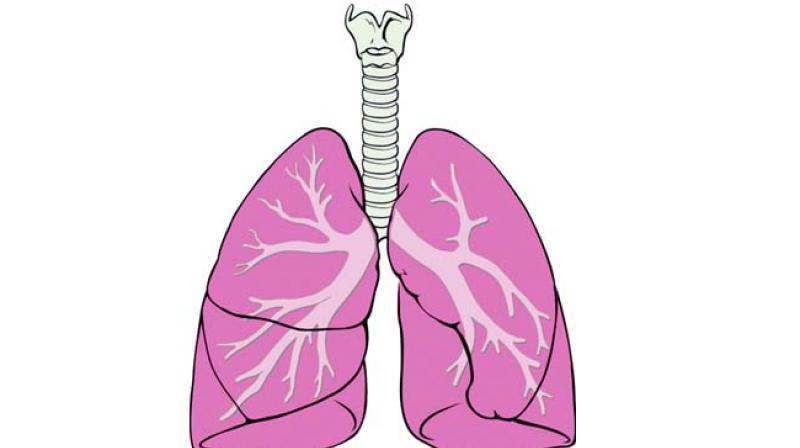Early detection can offer relief from lung diseases
Frequent infection or stubborn allergic cough must be examined further.

Hyderabad: Living with Chronic Obstructive Pulmonary Disease (COPD) is a major challenge. Getting through each day is often a struggle due to the difficulty in breathing and performing basic tasks. This is one aspect of the debilitating disease whose symptoms worsen over time and aggressive treatment or hospitalisation often compounds the problems rather than easing them.
COPD are a group of progressive lung diseases like chronic bronchitis, non-reversible asthma and emphysema in which breathing is difficult. COPD is chronic damage to the lungs which cannot be repaired and affects the overall quality of life. The disability due to breathing problems affects 76 per cent of the patients and its progress worsens and often patients are confined to bed.
Read | Lung diseases rising 3 times faster in women
In the past it was believed that this was only a man’s disease but new cases which are being diagnosed show that it is being being found three times faster in women than in men.
Dr Gongati Paramjyoti, pulmonologist at Nizam’s Institute of Medical Sciences, explained, “Out of the total number of patients with respiratory disorders, approximately 30 per cent suffer from COPD. Of this 10 per cent are women. It is one of the most underdiagnosed and undertreated diseases as the symptoms of chronic dry cough, phlegm and shortness of breath are confused with either a heart problem or tuberculosis.”
The misdiagnosing of the disease contributes to further worsening of the quality of life. It has been found that healed but post-infective tuberculosis is also considered as a risk factor for COPD but not in all cases. There is a need to create awareness among physicians and also amongst the people who have persistent cough and breathing difficulties for a longer period of time.
Dr Mahaboob Khan, professor of pulmonology and superintendent of Chest Hospital said experiencing an infection every two to three months or having an allergic cough that takes a longer time to heal must be evaluated further with a specialist.
"The reason is that the damage to the lungs do not have a direct symptom. Lungs are strong organs but if there is continuous insult, then the deterioration is faster. Those who are exposed to irritants like strong chemicals in factories, working in agricultural fields and spraying pesticides or those who are exposed to heavy vehicular pollution must get themselves checked if these symptoms persist,” Dr Khan said.
An early diagnosis can help to provide medication and curtail damage to the lungs. There can be symptomatic treatment with breathing exercises, diet modification and other lifestyle adjustments which will help to curtail the damage. Two main indoor pollution agents have been identified as the cause of COPD in women which are biomass fuel and passive smoking.
Biomass fuel is found to affect women in rural areas and most of them who come to hospitals have used it for more than 15 years.
In urban women, passive smoking affect 34 per cent females at the workplace and 54 per cent at home. Various studies have found that passive smokers were exposed to 85 per cent of the smoke present in the room while active smokers who were mostly men were exposed to potentially toxic components.
Dr Khan said, “Passive smoking has several subtle as well as explicit effects on the lungs. It leads to poor lung function, small airway dysfunction, and increased cough while inhaling cold air in non-smokers.”
Indoor and outdoor pollution are the risk factors for COPD and quality of air plays a major role in healthy living. Continuous long term exposure reduces life expectancy. Recent evaluations of the toxic air quality with particulate matter 2.5 levels reported to be more than 300 ug/m3 has stated that it can reduce life expectancy by 10 years.
Understanding COPD and its detection
A recent study published in the International Journal of Chronic Obstructive Pulmonary Disease has found that chronic cough must be taken as a marker for COPD and not chronic sputum.
Spirometry test is the cornerstone of COPD diagnosis. Spirometry is among the first, and one of the most non-invasive, tests used to diagnose COPD. In this test, a machine (a spirometer) measures how much air you can breathe in, and the force with which you can exhale that air back out.
Symptoms of COPD
Chronic cough which is long lasting and recurrent in nature. Often the cough
continues for more than three weeks. It is also dry in nature and hurting.
- Mucus production can be white, yellow or greenish in nature.
- Shortness of breath especially during physical activity.
- Wheezing.
- Tightening of the chest.
- Blueness of the lips or finger nails.
- Lack of energy.
- Swelling in ankles, feet or legs.
- Frequent respiratory infections.
- Lack of energy or fatigue.

